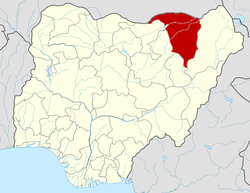INTRODUCTION
Yobe is one of the six states that form the North-East geopolitical zone of Nigeria. It shares interstate boundaries with Borno State to the East, Gombe State to the South, and Jigawa and Bauchi States to the West. Its northern border is shared with the Republic of Niger. Damaturu is the state capital.
LANDMASS, LOCATION AND POPULATION
Yobe State covers an area of 45,500 square kilometres and lies at latitude 12°00’ North and longitude 11°30’ East. It has a population of 2,321,339 (2006 census) 3,294,137 (2016 forecast) and a population density of 51. The state accounts for 1.7% of Nigeria’s population.
HISTORY AND PEOPLE
The Ngizim people were amongst the first groups to settle in the area cover by Yobe State. At the beginning of the sixteenth century, the town of Nguru was incorporated into the Kanem-Bornu Kingdom and was the seat of the Galadima (the governor of Bornu’s western provinces). For many years the town was fought over by the Hausa states and Bornu from 1509 till 1565 when Nguru fell under the rule of the Hausa king Muhammad Kisoki. The city was finally reclaimed by Bornu in 1808 during the Fulani Jihad and it became again the seat of the Galadima.
The emirate state of Potiskum was first established in 1809 by the Ngizim people. The emirate was merged with the Fika Emirate Council in 1915 by the British and its seat relocated to Potiskum in 1924. Yobe was originally part of the Northern Region in the three-region structure of 1954. Following the creation of twelve federal states by the military government of General Yakubu Gowon in 1967, it became part of North-Eastern State. When North-Eastern State was divided by the military government of General Murtala Muhammed in 1976, Yobe became part of Borno State. In 1991, Yobe State was carved out of the western half of Borno State by the military government of General Ibrahim Babangida.
Yobe is home to a number of ethnic groups, the most dominant of which are the Kanuri. The Fulani, Karekare, Ngizim, Bade and Hausa are also represented in the state. Islam is the main religion there.
MAIN TOWNS AND CITIES
Damaturu (capital), Potiskum, Gashau and Nguru.
LOCAL GOVERNMENT AREAS
ADMINISTRATORS AND GOVERNORS
Sani Ahmed (Governor – Military): August 1991 – January 1992
Bukar Ibrahim (Governor – Social Democratic Party)): January 1992 – November 1993
Dabo Aliyu (Administrator – Military): December 1993 – August 1996
John Kalio (Administrator – Military): August 1996 – August 1998
Musa Mohammed (Administrator – Military): August 1998 – May 1999
Bukar Ibrahim (Governor – Civilian (All People’s Party/; All Nigeria People’s Party)): May 1999 – May 2007
Mamman Ali (Governor – Civilian (All Nigeria People’s Party)): May 2007 –January 2009
Ibrahim Geidam (Governor – Civilian (All Nigeria People’s Party/All Progressives Congress)): January 2009 – May 2019
Mai Mala Buni (Governor - Civilian (All Progressives Congress): May 2019 - Present
ECONOMY AND EDUCATION
Gum arabic
Agriculture is Yobe’s main economic activity. Sorghum, millet, groundnut, cowpeas, maize, sesame and cotton are the main crops found in the state. Cattle herding is also widely practiced. The market town of Nguru is one of Nigeria’s major collecting points for gum arabic, groundnut, cotton, meat, hides and skins. A modern slaughterhouse and refrigeration plant were built there in the 1960s. The state has significant deposits of limestone, gypsum, kaolin, granite, silica and potassium. Industries located in the state include ceramics and agro-based industries. The people of the state are renowned for their production of leather works, pottery and weaving.
Tertiary institutions in the state are Yobe State University, Damaturu; Federal College of Technical Education, Potiskum and State College of Education, Gashua.
FAMOUS SITES AND CULTURE
Sites
Dufuna Canoe, Damaturu
The Dufuna Canoe is 8 metres long and was discovered by a herdsman in Dufuna village, Fune local government area in 1987. It is regarded as Africa’s oldest canoe and the second oldest known to man (the oldest being the one found in Pesse, Netherlands). Radiocarbon dating puts the age of the canoe at 8,500 to 8,000 years old. In 2014 it was listed as a historic heritage.
Tulo Tulo Desert Oasis, Yusufari
The Tulo Tulo Desert Oasis known as “The desert of Hope” lies between Nigeria and the Niger Republic border in Yusufari desert of Yobe State. It has a stunning landscape with sand dunes, palm trees and lakes and was discovered about a century ago by nomads looking for grazing land for their cattle.
Dagona Sanctuary Lake, Dagona
The Dagona Sanctuary Lake is a large ox-bow lake that supports different fish types and more than 25 species of bird. It is host to migrant birds from Europe and is breeding ground for a number of birds.
Culture
The Barakau festival is celebrated by inhabitants of the Karai-Kakai clans every year as thanksgiving for good harvests. It features traditional wrestling contests and dances performance by the youths. The Bade fishing festival is a major cultural event in villages along the River Yobe and takes place every year.
NOTABLE INDIGENES
Adamu Ciroma (1934 – 2018)
Mamman Ali (1958 -2009)
DID YOU KNOW
There are seven languages in Yobe namely Bade, Bole, Duwai, Karekare, Maka, Ngamo, and Ngizim. With the exception of Bole, which has many speakers in Gombe State to the south, Others are almost entirely concentrated in Yobe State.
YOBE STATE IN PICTURES

